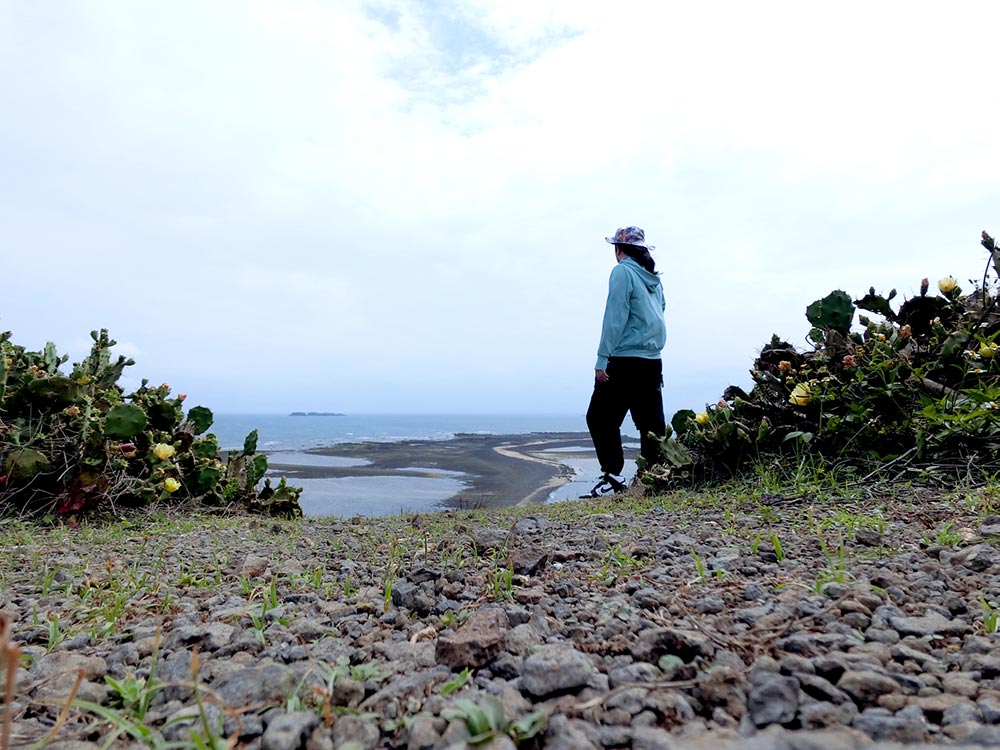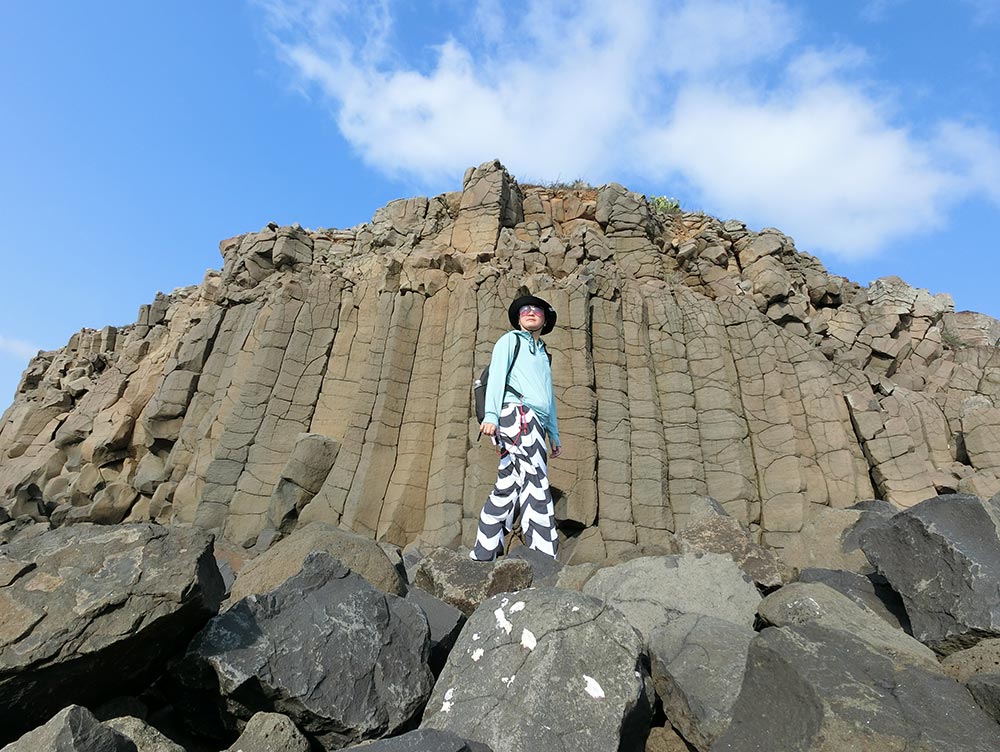Taiwan‘s offshore islands have their own unique character and the Matsu Islands are no exception. These rugged, hilly islands that are closer to China than Taiwan itself are popular domestic tourist destinations for tern watching and the blue bioluminescence phenomena. I visited the islands solo and here’s my guide on how to get to the Matsu Islands, getting around and all the practical info you need to plan your own trip.

Wondering what there is to see in Taiwan’s Matsu Islands? Stay tuned to my posts on the two main islands that I visited: Read my guide to Nangan and Beigan. This post deals with all the other nitty gritty you need to know and my experiences from visiting in May 2023.
The Matsu Islands tourism website is also a pretty useful resource overall – here’s the English site, but they actually have more info on the Chinese pages, so you might be better off using the Chinese site and then Google Translating the pages.
About my Matsu Island trip
I travelled to the Matsu Islands in May 2023 and spent 4 nights there in total – 2 nights in Nangan and then took a ferry over with a short stopover in Daqiu Island to spend 2 nights in Beigan. I flew in via Uniair from Taipei Songshan to Nangan, and flew out via Uniair from Beigan to Taipei Songshan. I travelled solo and mostly got around the islands by scooter.
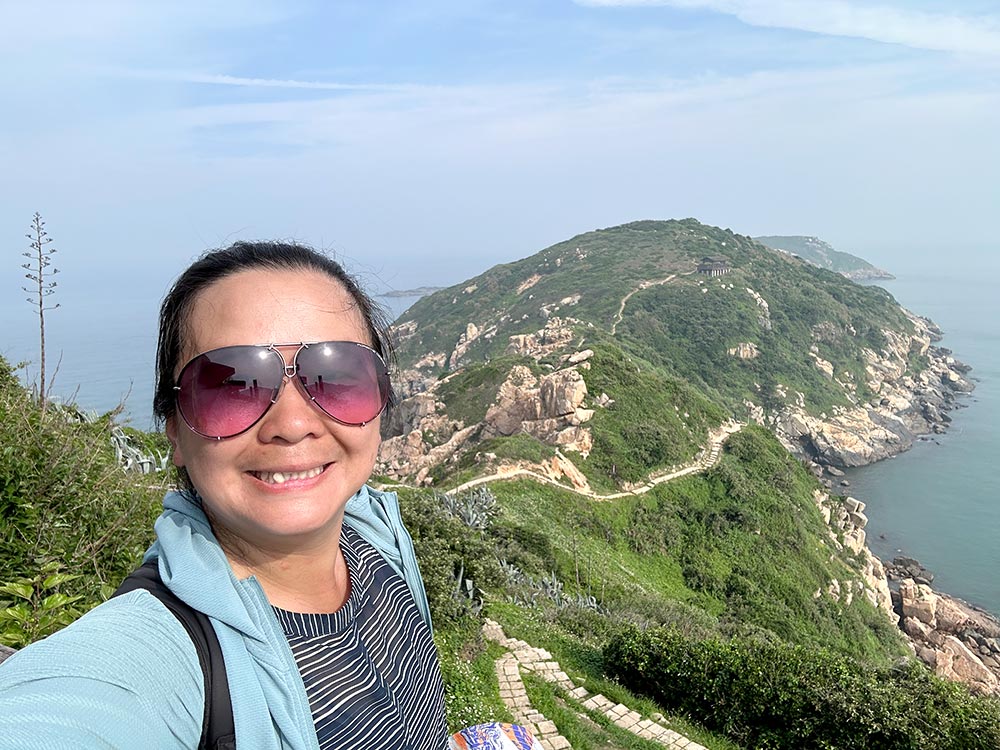
Where are the Matsu Islands located?
The Matsu Islands are one of Taiwan’s offshore islands, also known as Mazu 马祖. Geographically they’re a lot closer to China’s Fujian province than they are to mainland Taiwan itself – kinda like Kinmen Island.
In fact the Matsu Islands used to be considered a part of China, which is one of the reasons the islands ended up becoming a battlefront in the fight between Taiwan and China.
The Matsu Islands doesn’t just refer to a single island, but a collection of islands in Taiwan’s Lienchang County and are generally broken down into 4 areas:
- Nangan 南竿 – the main island in the Matsu Islands with the most facilities
- Beigan 北竿 – north of Nangan, it also has an airport
- Dongyin 東引 (north) – northernmost point of Matsu and Taiwan as a whole, is connected by land to Xiyin 西引
- Juguang 莒光 (south) – southernmost point of Matsu Islands, consists of Dongju 東莒 and Xiju 西莒
How to get to the Matsu Islands
By plane
The fastest way to reach the Matsu Islands is to fly from Taipei’s Songshan Airport (TSA) 松山 to Nangan Airport (LZN) 南竿 or Beigan Airport (MFK) 北竿 in about 1 hour. A 1-way ticket costs around 2,100-2,200 NTD (S$91-97).

A reminder that Songshan Airport (TSA) is in Taipei City itself and not to be confused with the Taoyuan International Airport (TPE). There are some international flights that go direct to Songshan Airport, but most international airlines fly to Taoyuan, so give yourself some time if you are planning transfers. There are direct buses between Taoyuan and Songshan airports every 20-30 minutes, the journey between the airports is about 50 minutes.
Airlines that fly to the Matsu Islands:
- UNI AIR 立榮航空 (li rong hang kong) flies daily with 8 flights between Taipei and Nangan and 3 flights between Taipei and Beigan – Check out UNI AIR’s website.
- Mandarin Airlines 華信航空 (hua xing hang kong) has one flight between Songshan and Nangan – check out Mandarin Airline’s website.

Some tips for flying to Matsu Islands:
- Book your flights as early as possible. The airports are tiny and the planes are small propeller planes and they get booked out quite quickly. The flights perpetually have a waiting list.
- Be prepared for delays or cancellations. Matsu Islands can get quite foggy which hampers plane landings. Heavy rains are another factor that makes it hard for planes. Make sure you have travel insurance and give yourself enough buffer if you need to catch a connection.
- Both UNI AIR and Mandarin Airlines have a free 10kg checked bag limit, but don’t worry if you exceed because each additional kilo is 16 NTD (S$0.70) per kg, but just note that you’ll need to pay this fee at the counter when you drop off your bag. In my experience, UNI AIR was pretty strict about charging this fee even if I was just 1kg over the limit because the system was automated, but Mandarin Air did things manually and didn’t bother charging me.
- You can make bookings and even select your seat online when you check in, but give yourself a little time to pick up the ticket at the airport because their system is more used to dealing with Chinese names, so longer English names where the surname/name are in different places from Chinese names means you probably can’t use the kiosks to get your ticket. Most of the counter staff made handwritten amendments to my name on the ticket after checking my passport, but I didn’t have any other issues.
Best for: Those with limited time or get seasick easily
Buy plane tickets at UNI AIR’s website or Mandarin Airline’s website. If you are strictly going for a 3D2N visit in a group, you can consider the round trip flight packages on KKday [affiliate link] as well.
By overnight ferry
If you have more time or plan to visit the northernmost island Dongyin as well, you could take the overnight ferry Taima Star 臺馬之星 from Keelung Harbour 基隆港 in New Taipei City that goes to Dongyin and Nangan in about 10-11 hours.
A 1-way ticket costs 1,100-1,200 NTD (S$48-52) for a single bed and 1,800-1,880 NTD (S$76-81) for 2 pax sharing a double bed.
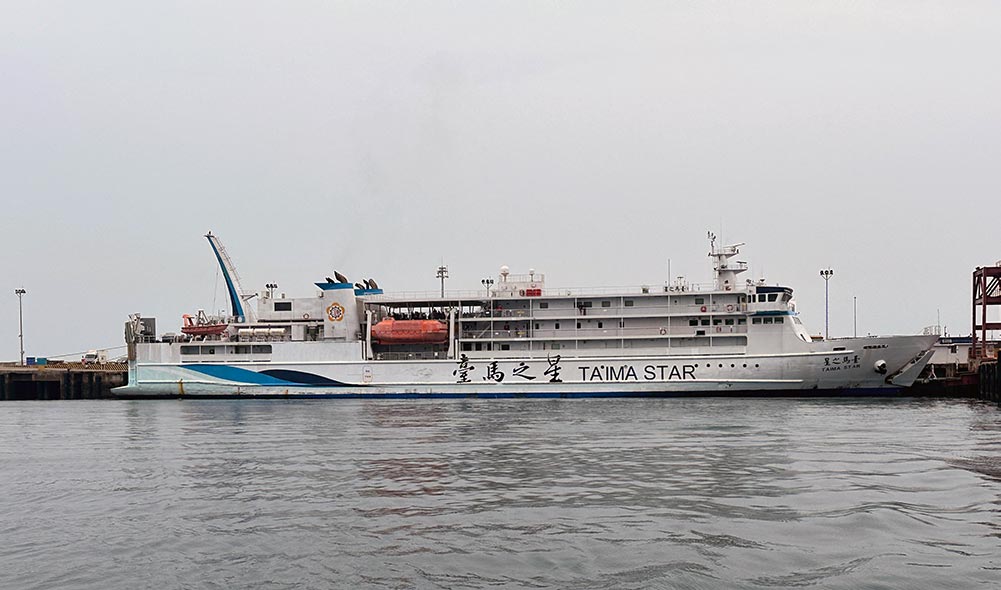
Taima Star Schedule
- Keelung Harbour – Nangan Fu’ao Harbour – Dongyin (Odd days)
- Keelung Harbour – Dongyin – Nangan Fu’ao Harbour (Even days)
I did want to try this out but because I was strapped for time, I ended up flying instead and skipped Dongyin altogether. Here’s an account by Luomujie about his time on the Taima Star if you’re curious. There are actual bunk beds and cabins to lie flat and sleep.
Best for: Those on a budget and have time to spare
Buy Matsu Overnight Ferry tickets on KKday [affiliate link] or on eMatsu
By fast ferry
A new fast ferry North-South Ferry 南北之星快輪 takes just 3 hours to get from Taipei Harbour 台北港 to Matsu Nangan Fu’ao Harbour 南竿 福澳港. A 1-way ticket costs 1,700-1,785 NTD (S$74-78).
If you’re wondering where Taipei Harbour is located, it’s in Bali, New Taipei City, across the river from Tamshui/Danshui.

Fast Ferry Schedule
- Taipei Harbour – Nangan Fu’ao Harbour: 10am -1pm
- Nangan Fu’ao Harbour to Taipei Harbour: 3pm – 6pm
I didn’t do this because I was on a tight schedule, but it sounds like a decent compromise between the long ferry rides and expensive flight tickets.
Best for: those unable to book flights and don’t get seasick
Buy Matsu Fast Ferry tickets on KKday [affiliate link] or on eMatsu
Travelling around the Matsu Islands
The only way to get around the various Matsu Islands is by boat. You can’t fly as the other islands don’t have airports, and helicopters are only for emergency situations.
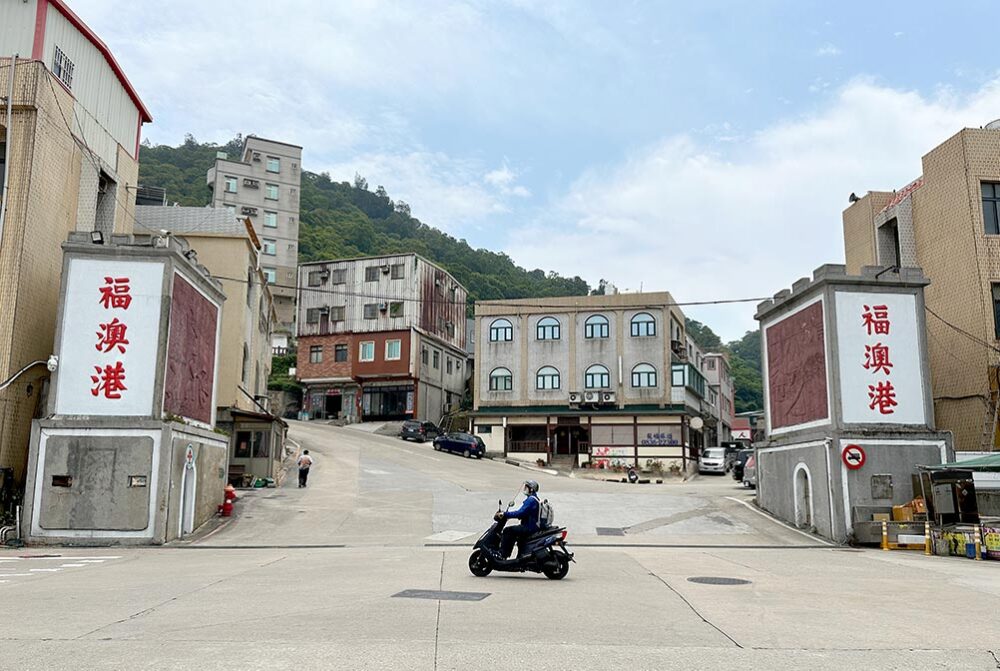
Nangan Fu’ao Harbour 南竿福澳港 is the main ferry hub in the Matsu Islands with frequent connections to neighbouring Beigan Baisha Harbour 北竿白沙港 (just 10 minutes away, many connections) and longer connections to Dongyin in the north (2 hours) as well as the Southern Juguang Islands (about 1 hour 45 minutes).
Book your ferry tickets via eMatsu or at the ferry terminal directly
Nangan – Beigan
There are ferries that go between Nangan and Beigan every hour from 7am to 530pm.
- Nangan > Beigan: The ferries from Nangan leave on the hour – 7am, 8am, 9am, 10am, 11am, 12pm, 1pm, 2pm, 3pm, 4pm, and the last ferry leaves at 510pm
- Beigan > Nangan: The ferries from Beigan leave on the half hour – 730om, 830am, 930am, 1030am, 1130am, 1230pm, 130pm, 230pm, 330pm, 430pm and the last ferry leaves at 530pm
Special ferry: Nangan – Daqiu – Beigan
Daqiu Island 大坵 is a small uninhabited island very close to Beigan that’s most famous for being home to a lot of Sika deer, so most people usually take a boat to Daqiu via Beigan’s Qiaozi Harbour.
If you’re going from Nangan to Beigan and want to stopover at Daqiu along the way, one other way is to take the North South ferry 南北之星from Nangan to Daqiu. The stopover in Daqiu island is about 2 hours, and then the boat drops by Beigan on the way back, so you can save yourself an additional boat ride on Beigan.

This ferry usually leaves Nangan at 920am and takes 20 minutes to get to Daqiu. I left my bag on the ferry to explore Daqiu for 2 hours, and then ended up in Beigan around noon. This boat runs from March to October, and during the peak months from May to August there is a second boat at 120pm. More info at Matsu Tourism (this page is only available in Chinese so just Google Translate it if you have to)
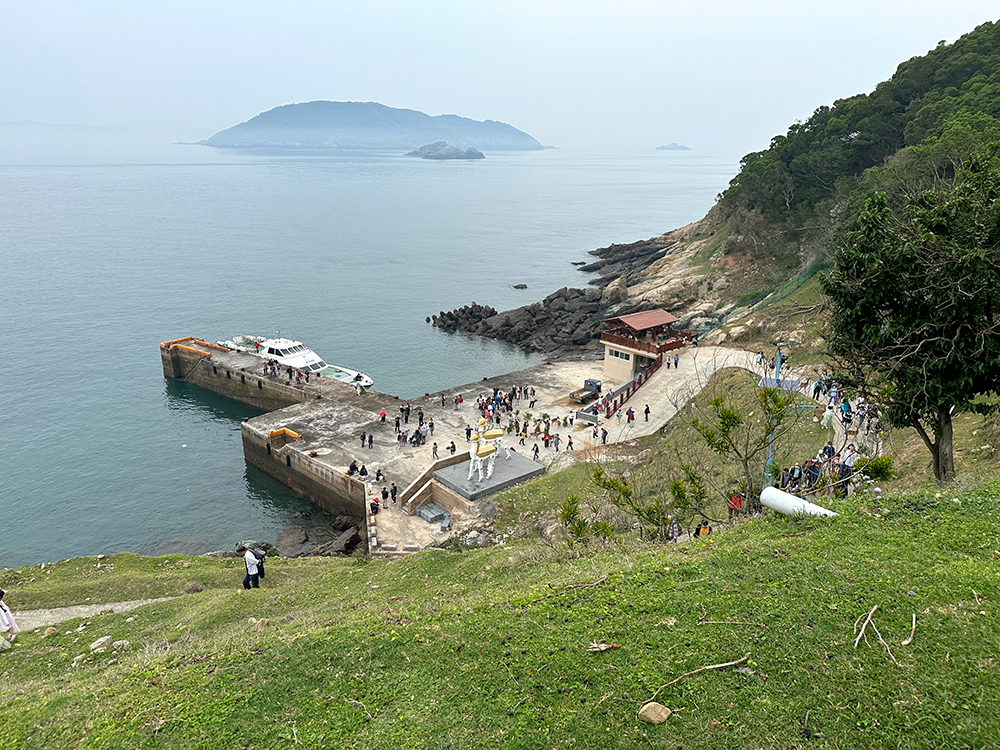
You honestly don’t need to spend very long on Daqiu cause it’s quite small – 2 hours is more than enough time to walk around the entire island!
This Nangan-Daqiu-Beigan ticket costs 350 NTD and can be booked online via eMatsu or at the ferry terminal directly
Getting around the Matsu Islands
Here are the maps used in the official Matsu Tourism brochures for reference.
Check out my guide on things to do in Nangan and my other Beigan island guide for more details about the places that I visited.
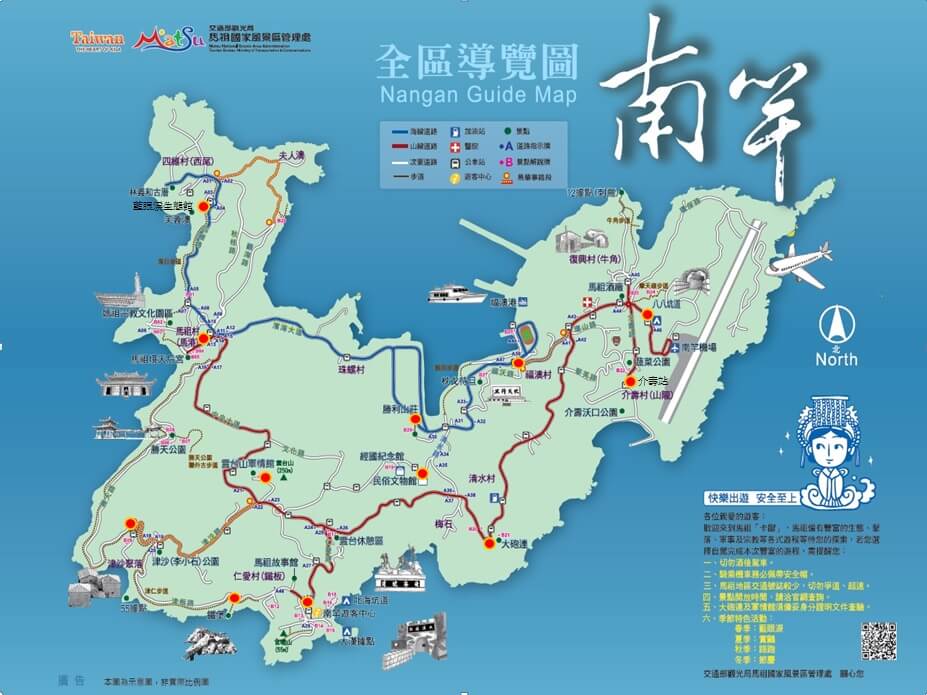
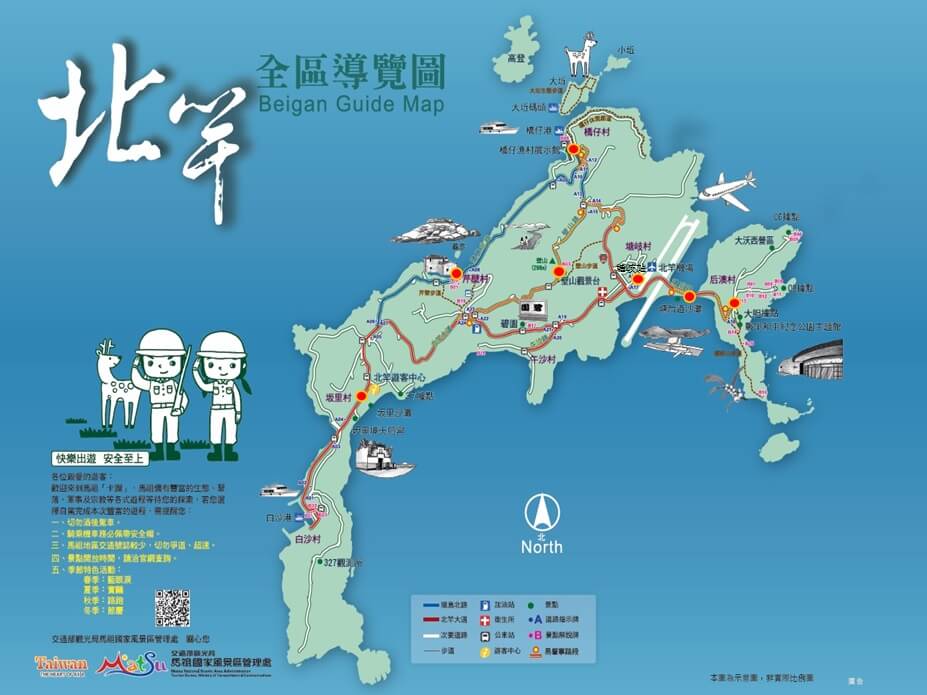
On Scooter
The most convenient way to navigate the Matsu Islands especially as a solo traveller is to ride a scooter. A warning here about Matsu’s terrain – it is extremely hilly. Now I thought Lanyu was pretty slopey, but here in Matsu Islands, these are some real steep hills.
I enjoy hopping on a scooter whenever possible in Taiwan’s outskirt areas, but if you have never ridden a scooter in your life or are not confident on the road, Matsu is NOT the place for you to try it out. Trust me on this.
If you do ride a scooter, definitely wear your helmet and make sure the brakes on your scooter work well. Remember to squeeze both brakes and don’t panic squeeze just one or you might end up flying off the bike. Take your time on those crazy slopes!

For those who don’t plan to ride, you could look into renting a car, taking a taxi or hiring a driver instead. Your guesthouse should be able to help you arrange this.
Public Bus
If you don’t have your own transport option, Nangan and Beigan both have public buses that go around the islands. You can pick up the latest bus schedule at the visitor centre (it’s printed on the brochures), but in general you have 1-2 buses running every hour from 7am – 5pm.
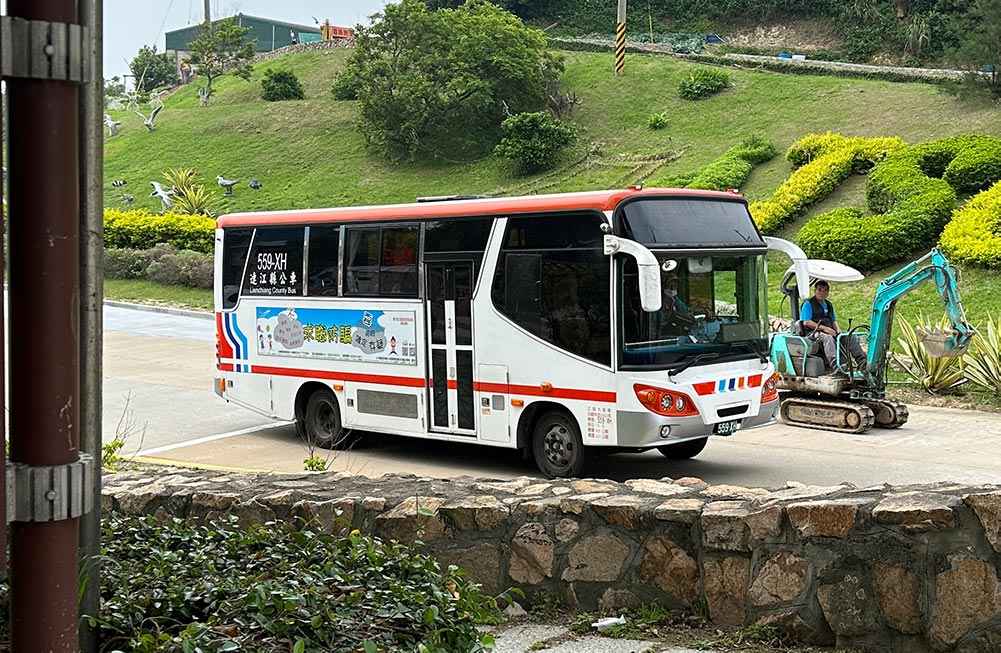
Taiwan Haoxing Tourist Shuttle Bus 台灣好行
One easy way to explore the Matsu Islands is to make use to the Taiwan Tourism shuttle buses. Similar to the Hualien East Coast Shuttle Bus that I took, these buses function like a mini half-day tour and take you to the main sights in Matsu without you having to worry about transport. The only issue is that you have a fixed schedule to follow. Each trip costs 300 NTD.
The Nangan Tourist Shuttle bus operates in the morning (121) and the afternoon (122) with different routes.
The Beigan Tourist Shuttle Bus operates in the morning (221) and the afternoon (222) with different routes
Where to stay in the Matsu Islands
Figuring out your accommodation options? Here’s where I stayed in the Matsu Islands and some of my recommendations.
Accommodation Booking Tips
I usually book accommodation through booking.com because of convenience and I do get discounts as a frequent user, but one option you can consider is to use Google maps to find hotels/guesthouses that you like, and then contacting these places via email, LINE or phone if you can speak Chinese. These guesthouses can usually offer you better rates or packages directly.
A note that the standard practice in Taiwan is usually to transfer a deposit to the guesthouse as a pre-booking fee, but if you tell them you’re not in/from Taiwan, they usually are ok to let you pay on arrival.
So far I haven’t found any method of making transfers to Taiwanese accounts in NTD easily, which is more due to Taiwan’s rather closed banking system – multi currency sites like Revolut and Wise don’t let you create NTD wallets, and the transfers to Taiwan are in USD for some reason as well.
Nangan – Jinsha Vanilla Homestay 南竿津沙香草民宿
I chose to stay at Jinsha Village 津沙聚落 in the southwest corner of Nangan Island. It’s a historic village in Nangan that many people visit and takes about 15 minutes to get to by car from Nangan airport.
I stayed at Jinsha Vanilla Homestay [booking.com affiliate link] which was quite conveniently located in the ‘center’ of the village. The owners were an accommodating couple who picked me from the airport when I arrived, dropped me at the ferry harbour when I left and gave me pretty good tips on sights to see around the island.
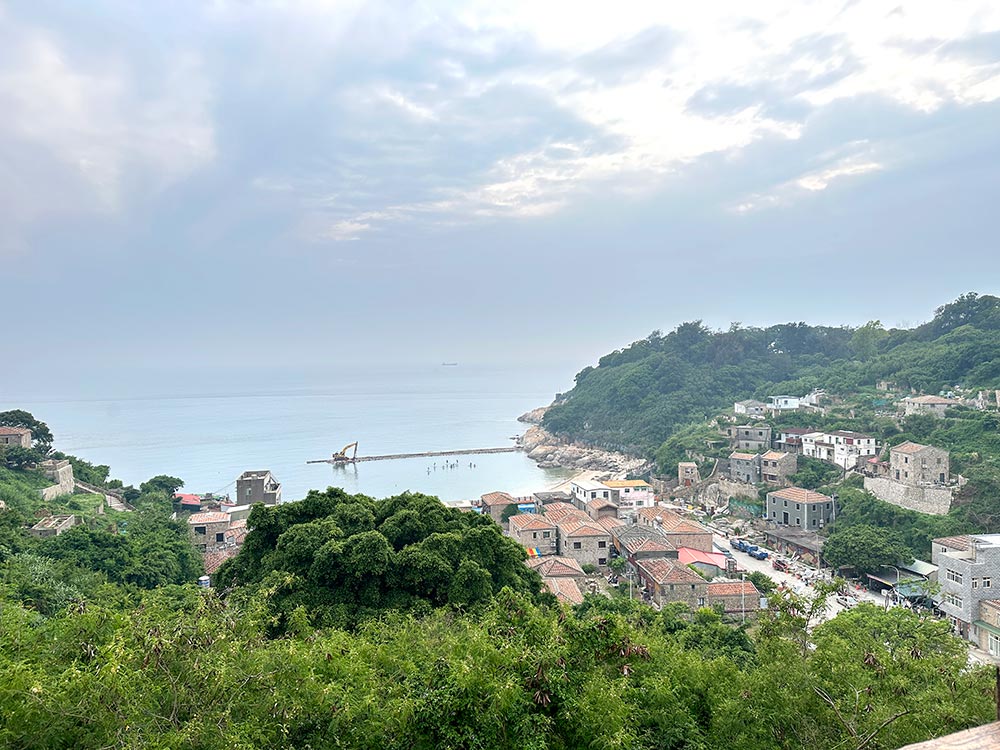



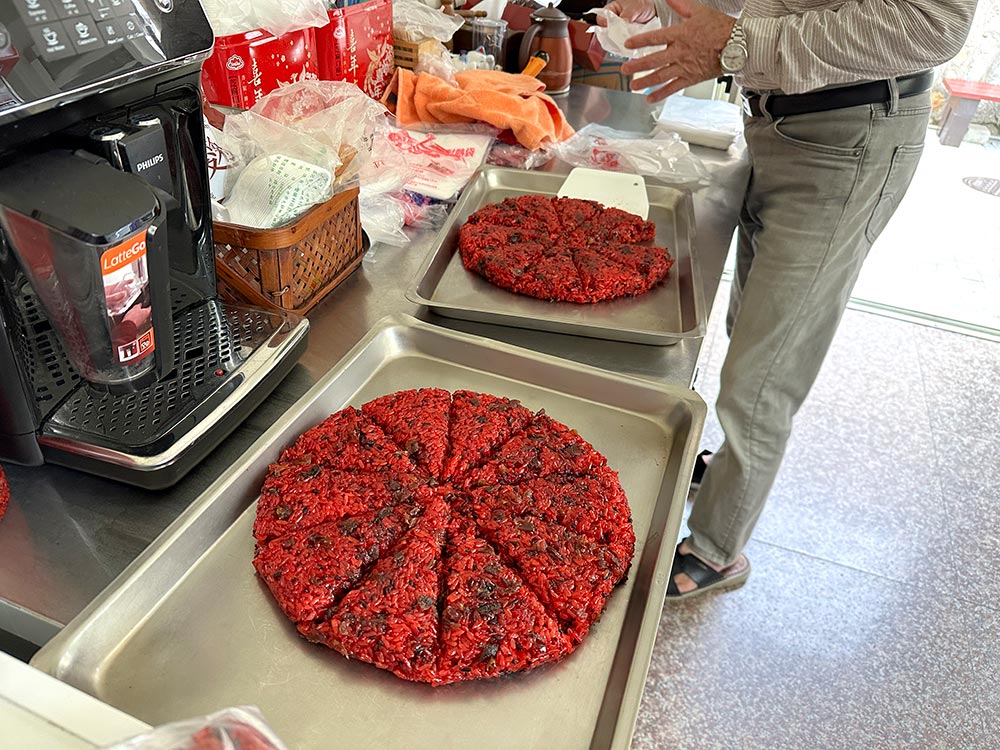
They sold snacks and drinks during the day so every morning I got to eat freshly made local snacks. I also rented my scooter directly from them. This guesthouse has just two rooms on the upper level so there was a shared toilet (the owners lived in the room downstairs).
Some other options in Nangan you can consider [booking.com affiliate links]
- Jinsha Di’an 津沙堤岸 – Also in Jinsha Village, this one has a seaview closer to the Jinsha beach
- Matsu Seaside View Homestay – overlooking Ren’ai Beach, close to the Beihai Tunnel
- Matsu B&B – In Jieshou Village very close to the airport
Beigan – Qinbi Qingnian Homestay 芹壁青年民宿
On Beigan Island, I also opted for the historic village of Qinbi 芹壁聚落 and it really was very pretty. Traditional old stone houses and little narrow alleyways and staircases.
I stayed at Qinbi Qingnian Homestay [booking.com affiliate link] which was in a traditional house which means a couple of things – no ensuite bathrooms and pretty small rooms, but overall it was cosy and I had a bit of a seaview from my room.
My guesthouse owners again picked and dropped me off, but they didn’t live in the house itself so I had it all to myself on the 2nd night when the other guest left! There are 3 rooms in total – I was up on the 3rd floor and it can sleep 8 people, so if you have a group you can book the whole house.
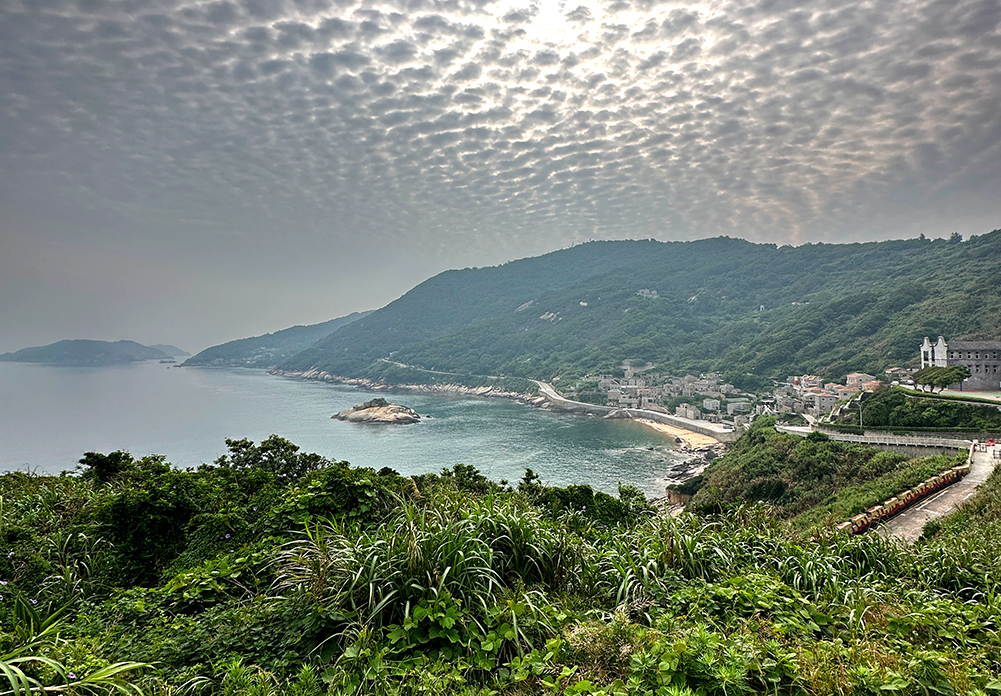

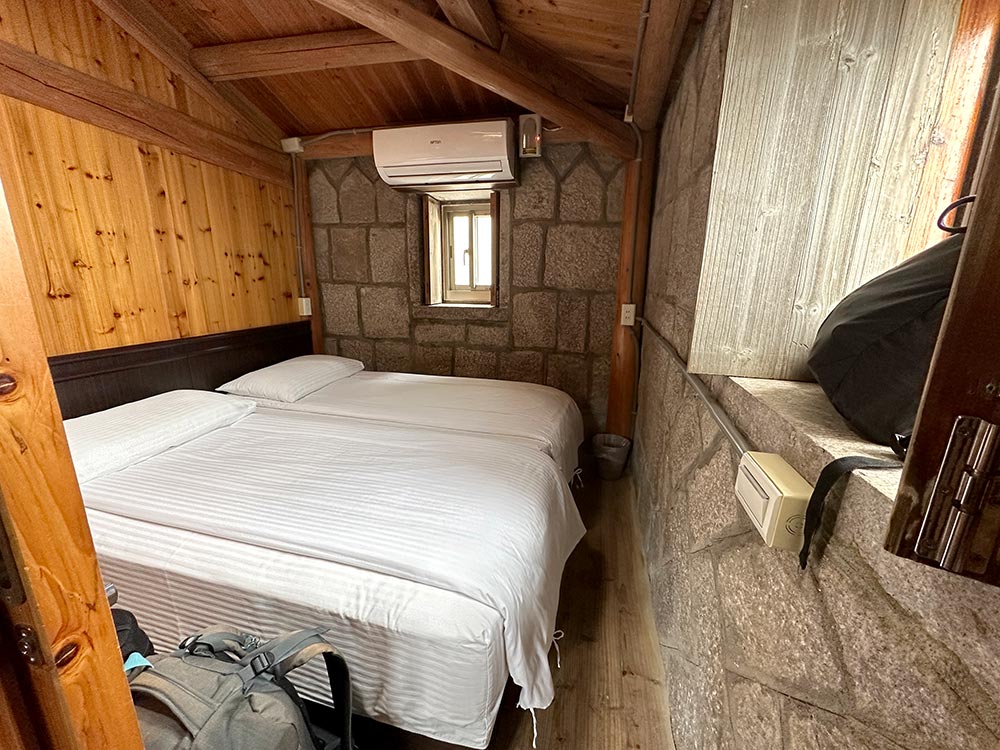
Some other options in Beigan you can consider [booking.com affiliate links]
- Yo Ho 23 Homestay – also located in Qibi, this one looks like a pretty place to stay
- So Lohas B&B – the rooms at this guesthouse at Qiaozi have balconies and it looks pretty nice
- Chingya House – centrally located in Tangi Village near the airport
Best time to visit the Matsu Islands
The best time to visit Matsu Islands largely depends on what you want to see or do when you are there.
Blue Tears: Late April to October is recommended as the water needs to be warmer to see the glowing algae. April to June is considered the peak Blue Tears season – I visited in mid May and saw some of the brightest Blue Tears glows for the 2023 season! Check out my Blue Tears guide for details.
Tern Watching: The Chinese Crested Terns are best seen in summer when it is hot from June to October when they are migrating and passing through the Matsu Islands. Peak tern watching happens in July and August.
Festivals:
- Baiming and Yingshen – 15th day of 1st lunar month, around February
- Mid Autumn Festival Pagoda Burning – 15th day of 8th lunar month, around September
- Matsu Ascension Day – 9th day of 9th lunar month, around October
- Matsu Marathon – early November
I picked May because I wanted to see the Blue Tears and enjoy slightly cooler temperatures before things got too hot.
Other Matsu Island Travel Tips
Have extra TWD on hand
Here’s the thing about island life in Taiwan, even on larger islands such as Penghu: ATMs are few and far between, and even if you do find an ATM, there’s a high chance that it doesn’t take foreign cards.
I know this because I was nearly stuck without cash on my last day on the Matsu Islands. Beigan has ONE single ATM machine at the Chunghwa post office in Tangqi Village that unfortunately does not accept foreign credit cards. The staff said MAYBE Nangan (which is slightly bigger) might have an international ATM… Luckily I paid my guesthouse in cash and they were willing to accept credit card instead so I managed to get my cash back from them.
The Matsu Islands are a little pricier than you might think. Because of its remoteness, some of the eateries cost about the same as a cafe in Singapore, which is expensive by Taiwanese standards. Withdraw more than you think you will need at the ATMs at Songshan Airport before you fly – there are ATMs there that don’t charge international fees.

Expect early nights
Matsu has very little in way of nightlife – most places are open in the day and even when it comes to dinner, there aren’t that many options. In Jinsha Village where I stayed in Nangan there were just two restaurants open for dinner at night.
Things also tend to close early, so start thinking about dinner by 6pm latest to ensure you don’t go hungry. There are some small convenience stores in some of the larger villages but these don’t run 24 hours – they were pretty useful when I ran out of cash as I could pay with your credit card/EasyCard.
In the summer months, night time is for Blue Tears hunting! Up your chances at seeing the Blue Tears by staying near a beach.

Stick to main highways at night
If you’re exploring at night, stick to the main highways that cut through the center of the islands (the bus route) and avoid the smaller roads as not all the small roads are lit at night. The main highways might be a longer distance, but while they are slopey, they are well paved and lit by roadlamps.
The smaller roads may be equally slopey but not fully paved – some of them have this half paved stone and half smooth concrete which is rather precarious for a scooter if you hit the road at the wrong angle, especially at night.

Have you been to the Matsu Islands in Taiwan? I definitely want to go back again and see the islands that I’ve missed out on. Check out my Nangan and Beigan posts for detailed recs on things to do in the Matsu Islands.
I’ve visited all of Taiwan’s offshore islands! Check out all my Taiwan offshore islands posts or see all my Taiwan posts.


